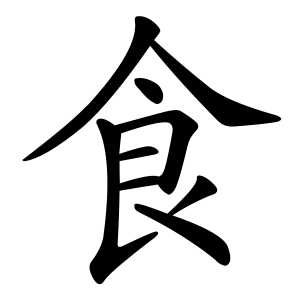食
- meal, food, rice;
- to eat;
Etymology
There are several theories regarding the etymology of the character 食 (식).
According to the Shuowen Jiezi (説文解字 shuōwén jiězì), it is explained as a phonosemantic compound character:
皀 represents the meaning, interpreted as “the smell of grains or food,”
亼 provides the sound.
In the field of ancient Chinese character studies, other interpretations exist: Some see 皀 as depicting a vessel filled with food, and 亼 as either a 180-degree inverted form of 口 (mouth), symbolizing consumption, or as a lid covering a food container.
Usage in Korean
Interestingly, when 食 means “cooked rice” or “meal” as a noun, it can also be read as "사" in Korean.
A representative example of this is the classical idiom 단사표음 (簞食瓢飮) — meaning “a basket of rice and a gourd of water,” symbolizing a simple, humble lifestyle.
Additionally, 食 is sometimes used as a variant for 飼 (사, "to feed"), especially in classical Chinese texts. In such cases, 食 is interpreted not as “to eat” (먹다) but in its causative form, meaning “to feed” (먹이다).
It appears in many everyday words such as:
식사 (食事) – meal
음식 (飮食) – food and drink
식욕 (食慾) – appetite
식품 (食品) – food product
As a semantic radical, when attached to other characters, it typically conveys meanings related to food, eating, or meals.
This radical appears in many food-related characters, such as:
飯 (밥 반) – rice, meal
飼 (먹일 사) – to feed
飢 (주릴 기) – hunger
飲 (마실 음) – to drink
Alternative forms
When used on the left side of a character, it often changes shape to either:
𩙿 – commonly used in Korea,
飠 – the standard in Japanese shinjitai, Taiwan, and Hong Kong traditional characters,
饣 - in Simplified Chinese (Mainland China).
In handwriting, even in Korea, 飠 is often preferred for its simplicity.
Characters with 食
- 人戈日女 (OIAV)
- ⿱ 人 良 (G J)
- ⿱ 亼 艮 (H K T V)
